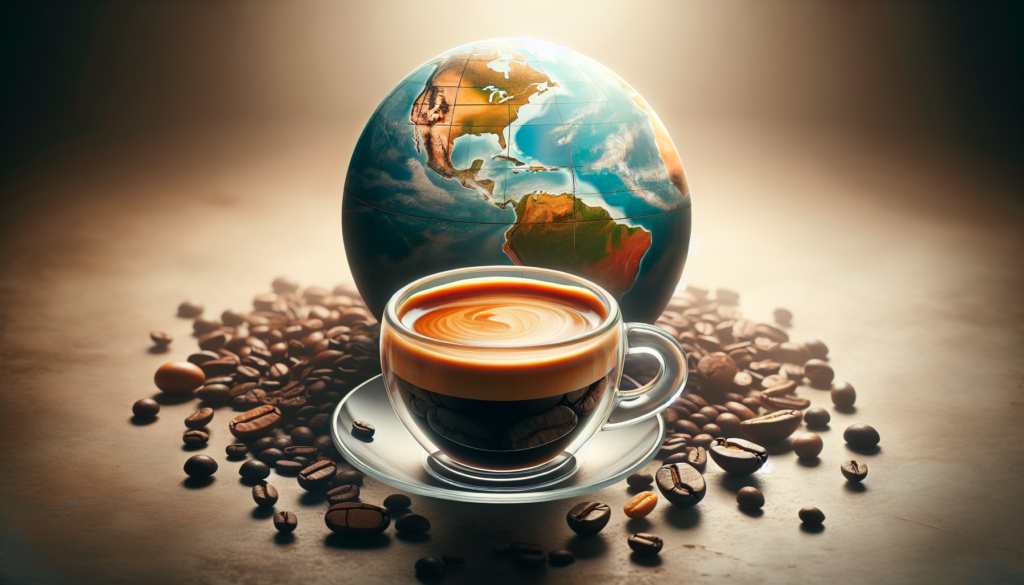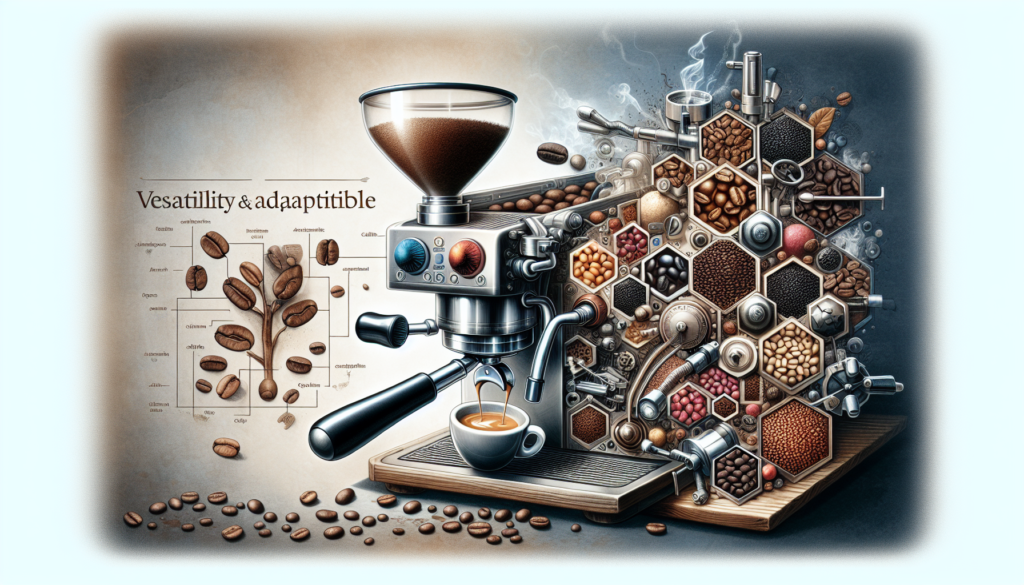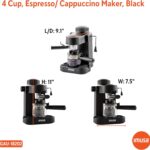So, you’re wondering if you can whip up that rich and velvety espresso with just any old coffee laying around in your pantry, huh? Well, you’ve come to the right place! In this article, we’ll explore the possibility of making espresso using different types of coffee beans, and whether or not it will live up to your caffeine-fueled expectations. So grab a cup of your favorite joe, sit back, and let’s get brewing!
Understanding Espresso
What is Espresso?
Espresso is a concentrated form of coffee that is brewed by forcing pressurized hot water through finely ground coffee beans. It originated in Italy and is known for its rich, intense flavor and velvety texture. Unlike regular coffee, which is brewed by steeping coffee grounds in hot water, espresso is prepared using an espresso machine that can generate the high pressure needed for extraction.
Characteristics of Espresso
Espresso is characterized by its strong, bold flavor profile, which can range from nutty and chocolatey to fruity and floral, depending on the coffee beans used. It also has a thick, syrupy consistency and a layer of crema, a creamy foam that forms on top of the espresso shot. The crema adds to the visual appeal of the espresso and helps to enhance the overall drinking experience.
Brewing Espresso vs. Regular Coffee
The process of brewing espresso differs significantly from brewing regular coffee. While regular coffee is made by allowing hot water to pass through coarser coffee grounds, espresso requires finely ground coffee and a high-pressure espresso machine. The high pressure used in espresso extraction extracts more of the coffee’s soluble flavors, oils, and aromas, resulting in a more intense and concentrated beverage. The brewing time for espresso is also much shorter, typically around 25-30 seconds, compared to several minutes for regular coffee.
Choosing the Right Coffee Beans
Why Coffee Beans Matter
The choice of coffee beans is crucial when it comes to making espresso. The beans you choose will greatly impact the flavor, aroma, and overall quality of your espresso. It’s essential to select high-quality, freshly roasted beans that have been specifically roasted for espresso brewing. The origin, variety, and processing method of the coffee beans all contribute to the unique characteristics of the resulting espresso.
Ideal Coffee Beans for Espresso
When selecting coffee beans for espresso, it is generally recommended to choose medium to dark roasted beans. Medium roasts offer a balance between the bean’s natural flavors and the roasting process, while dark roasts provide a more intense and robust flavor profile. Additionally, using beans labeled specifically for espresso will ensure that the roasting process has been optimized to bring out the desired flavors and aromas in the espresso.
Roast Level and Espresso
The roast level of the coffee beans has a significant impact on the flavor profile of the resulting espresso. Lighter roasts tend to retain more of the coffee’s natural acidity and fruity flavors, resulting in a brighter and lighter-bodied espresso. On the other hand, darker roasts have a bolder and more intense flavor, often with notes of chocolate and caramel. The choice of roast level ultimately depends on personal preference, with some individuals preferring a lighter, more nuanced espresso, while others enjoy the boldness of a dark roast.
Differences between Arabica and Robusta
When it comes to espresso, the two most common types of coffee beans used are Arabica and Robusta. Arabica beans are generally considered to be of higher quality and are known for their delicate flavors, pleasant acidity, and aroma. They are often preferred for making specialty espresso drinks due to their complex flavor profiles. Robusta beans, on the other hand, are more robust and bitter, with higher caffeine content. While they are sometimes used in espresso blends to add body and crema, they are generally not favored for single-origin espressos due to their stronger and less refined taste.

Grinding Coffee Beans
Importance of Proper Grinding
Grinding the coffee beans to the correct consistency is crucial for extracting the best possible flavor from the espresso. The grind size affects the rate of extraction, with finer grinds allowing for faster extraction and coarser grinds resulting in a slower extraction. Consistency in particle size is also essential to ensure an even extraction, as uneven grinding can lead to under-extraction or over-extraction of the coffee, resulting in a bitter or weak-tasting espresso.
Types of Coffee Grinders
There are two main types of coffee grinders commonly used for grinding coffee beans: blade grinders and burr grinders. Blade grinders use rotating blades to chop the coffee beans into small particles, but they often result in an uneven grind size. Burr grinders, on the other hand, crush the beans between two burrs, resulting in a more consistent grind. Burr grinders are generally preferred for espresso brewing as they allow for precise control over the grind size.
Optimal Grind Size for Espresso
When brewing espresso, a fine grind size is necessary to ensure sufficient extraction and the creation of a balanced shot. The ideal grind size is similar to that of table salt or slightly finer. The finer grind allows for increased surface area contact with the water during extraction, which enhances the flavor and aroma of the espresso. It is important to note that the grind size may need to be adjusted based on personal preference, the specific espresso machine being used, and the type of coffee beans.
Extracting Espresso
The Espresso Machine
An espresso machine is essential for brewing espresso. There are various types of espresso machines available, including manual lever machines, semi-automatic machines, and fully automatic machines. These machines use a combination of pressure, water, and heat to produce the espresso shot. It is important to choose a machine that suits your needs and level of expertise, as different machines offer varying degrees of control over the brewing process.
Pressure and Temperature
Pressure and temperature are critical factors in extracting espresso. The ideal pressure for extraction is typically around 9 bars, although some machines may vary. This pressure allows for the extraction of the coffee’s flavors and oils without imparting excessive bitterness. The water temperature should be between 195°F and 205°F (90°C to 96°C) to achieve proper extraction. If the water is too cool, the espresso will be under-extracted, resulting in a weak and sour taste. Conversely, if the water is too hot, the espresso can become over-extracted, leading to a bitter and burnt flavor.
Portafilter and Tamping
The portafilter is a key component of the espresso machine that holds the ground coffee during extraction. It is important to ensure that the portafilter is clean and dry before use to maintain optimal flavor. Tamping, the process of compressing the coffee grounds inside the portafilter, helps to create an even extraction. A consistent and level tamp ensures that the water passes through the coffee evenly, preventing channeling and ensuring a uniform flavor profile in the espresso shot.
Duration of Extraction
The duration of extraction plays a crucial role in determining the strength and flavor characteristics of the espresso shot. Typically, the extraction should take around 25-30 seconds. If the extraction is too short, the espresso will be weak and lacking in flavor. Conversely, if the extraction is too long, the espresso can become over-extracted and taste bitter. Adjustments to the grind size, coffee dose, or extraction time can be made to achieve the desired flavor balance.

Factors Affecting Espresso Quality
Water Quality and Temperature
The quality of water used in espresso brewing has a significant impact on the final taste of the espresso. It is recommended to use filtered water or bottled spring water to avoid any unwanted flavors or impurities. Additionally, maintaining the proper water temperature is crucial for optimal extraction. The espresso machine’s heating element should be regularly maintained and calibrated to ensure that the water reaches the desired temperature range consistently.
Brewing Time
The brewing time, or the duration of extraction, directly affects the strength and flavor profile of the espresso. As mentioned earlier, the ideal extraction time is around 25-30 seconds. This timeframe allows for the extraction of desirable flavors while avoiding over-extraction. Consistency in brewing time is essential to ensure that each shot of espresso is of the same quality and flavor.
Coffee-to-Water Ratio
The ratio of coffee to water used in espresso brewing also impacts the strength and overall flavor profile of the espresso. The standard ratio is typically around 1:2, meaning 1 gram of coffee to 2 grams of water. However, this ratio can be adjusted based on personal preference. Increasing the coffee-to-water ratio will result in a stronger and more concentrated espresso, while decreasing the ratio will produce a milder and less intense shot.
Cleanliness of Equipment
Maintaining clean espresso equipment is crucial for producing high-quality espresso. Regular cleaning and descaling of the espresso machine, portafilter, and group head help to remove any buildup or residue that can affect the flavor of the espresso. Proper cleaning also ensures that the espresso equipment functions optimally and prolongs its lifespan.
Alternative Brewing Methods
Moka Pot
The Moka pot is a stovetop coffee maker that brews coffee by passing pressurized steam through a funnel containing coffee grounds. While it does not produce true espresso due to the lower brewing pressure, it can create a concentrated and flavorful coffee beverage that resembles espresso. The Moka pot is a popular alternative for espresso lovers who do not have access to an espresso machine.
French Press
The French press, also known as a press pot or plunger pot, is a full-immersion brewing method that uses a mesh plunger to separate the coffee grounds from the brewed coffee. It does not produce espresso as the brew time is longer, but it can create a rich and full-bodied coffee with robust flavors. French press coffee can serve as a good base for making espresso-based beverages with an espresso machine.
Aeropress
The Aeropress is a unique coffee brewing device that uses air pressure and immersion to extract coffee. It produces a concentrated and clean coffee that can resemble espresso to some extent. The Aeropress is highly versatile and allows for experimentation with different brewing techniques, making it an excellent choice for those who enjoy exploring different flavor profiles.
Pour-Over
Pour-over coffee brewing involves pouring hot water over coffee grounds placed in a filter, allowing the water to pass through and extract the flavors. While pour-over coffee is not comparable to espresso, it can produce a clean and nuanced cup of coffee. The pour-over method allows for precise control over the brewing process, making it a favorite among coffee enthusiasts.
Experimenting with Different Coffees
Single-Origin vs. Blends
When exploring different coffees for espresso, you have the option of choosing between single-origin beans and blends. Single-origin beans come from a specific region or farm and highlight the unique characteristics of that particular coffee-growing area. They can offer distinctive flavor profiles and showcase the terroir of the coffee. On the other hand, espresso blends combine beans from multiple origins to create a balanced and consistent flavor profile. Blends are often designed to achieve a specific taste profile that appeals to a wider range of palates.
Flavor Profiles and Acidity
Coffee beans can exhibit a wide range of flavors, from fruity and floral to chocolatey and nutty. When selecting coffee beans for espresso, consider the flavor profile that appeals to you the most. Fruity and floral coffees can bring brightness and complexity to the espresso, while chocolatey and nutty coffees offer a comforting and rich flavor profile. Additionally, acidity plays a vital role in espresso, providing a lively and vibrant taste that complements the other flavor components.
Caffeine Content
Espresso is often associated with being higher in caffeine content compared to regular coffee. However, the caffeine content of an espresso shot can vary depending on factors such as the coffee beans used, the extraction process, and the serving size. Contrary to popular belief, darker roasts actually contain slightly less caffeine than lighter roasts. It is essential to note that a standard espresso shot typically contains less liquid volume than a regular cup of coffee, but the concentration of caffeine can be higher due to the fast extraction process.
Using Flavored Coffees for Espresso
Flavored coffees, such as those infused with various extracts or essences, can be used to create unique and enjoyable espresso-based beverages. However, it is important to select high-quality flavored coffees that do not overpower the natural flavors of the coffee beans. Flavored coffees can add a hint of additional complexity and aroma to your espresso, allowing for a personalized and exciting espresso experience.
Skill and Technique
Barista Skills
Becoming a skilled barista requires practice, patience, and a willingness to continuously learn and improve. Skillful baristas possess the ability to consistently produce high-quality espresso shots by understanding the proper techniques, adjusting variables as needed, and ensuring proper maintenance and cleanliness of equipment. They are knowledgeable about different coffee beans, brewing methods, and flavor profiles, allowing them to create a memorable and enjoyable coffee experience for their customers.
Practice and Refinement
Mastering the art of espresso brewing takes time and dedication. It is important to practice consistently, experimenting with different variables such as grind size, extraction time, and water temperature. Learning to taste and evaluate the flavors and qualities of your espresso shots will help you identify areas for improvement and guide your refinement process. As you refine your technique and develop a deeper understanding of the brewing process, you will be able to consistently create exceptional espresso shots.
Latte Art
Latte art adds a touch of creativity and visual appeal to espresso-based beverages. It involves creating intricate patterns and designs on the surface of the steamed milk by carefully pouring it into the espresso. Baristas skilled in latte art can produce beautiful designs such as hearts, rosettas, and even elaborate free pour art. While latte art is not essential for enjoying a delicious espresso, it can enhance the overall experience and create a sense of craftsmanship.
Enjoying Espresso-Based Beverages
Classic Espresso
The classic espresso shot is a pure, concentrated form of coffee that can be enjoyed on its own. Served in a small demitasse cup, it is the foundation of various espresso-based specialty drinks. Classic espressos are known for their bold and intense flavors, often exhibiting a balance of sweetness, bitterness, and acidity. Savored slowly, a well-prepared espresso shot can offer a rich and memorable coffee experience.
Cappuccino
A cappuccino is a popular espresso-based beverage that combines equal parts espresso, steamed milk, and milk foam. It is typically served in a larger cup or glass and is enjoyed for its creamy texture and balanced flavor. The espresso provides the base and intensity, while the milk and foam add sweetness and a velvety mouthfeel. Cappuccinos are often adorned with a dusting of cocoa or cinnamon on top.
Latte
A latte is a milky espresso-based drink that consists of a shot of espresso topped with steamed milk and a small amount of milk foam. It offers a delicate balance of espresso strength and milk sweetness. Lattes can be customized with flavored syrups and can be enjoyed hot or iced. Latte lovers appreciate the smooth and creamy texture of the steamed milk, which complements the boldness of the espresso.
Macchiato
A macchiato, meaning “stained” in Italian, is a small espresso topped with a dollop of frothy milk. It is a bolder alternative to a latte, with a higher coffee-to-milk ratio. Macchiatos are known for their strong and pronounced espresso flavor, with a touch of sweetness from the milk. They are often served in a demitasse cup and can be enjoyed as a quick pick-me-up or a more assertive espresso experience.
Americano
An Americano is a diluted espresso beverage that combines a shot of espresso with hot water. This method creates a coffee with a flavor profile similar to regular brewed coffee but with the boldness and intensity of an espresso. Americanos are ideal for those who enjoy a milder coffee without sacrificing the unique character of an espresso shot. They can be customized with added milk or flavored syrups, depending on personal preference.
Conclusion
The process of making espresso is a delicate and nuanced craft that combines the art and science of coffee brewing. Understanding the key elements that contribute to a high-quality espresso, such as the choice of coffee beans, proper grinding, extraction techniques, and other factors, allows you to create a truly exceptional cup of espresso. By exploring different flavors, experimenting with brewing methods, and continuously refining your skills, you can master the art of espresso and enjoy a personalized and fulfilling coffee experience. So go ahead, savor that rich crema and indulge in the exquisite world of espresso.






